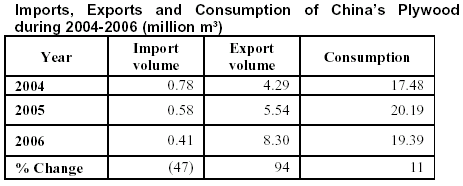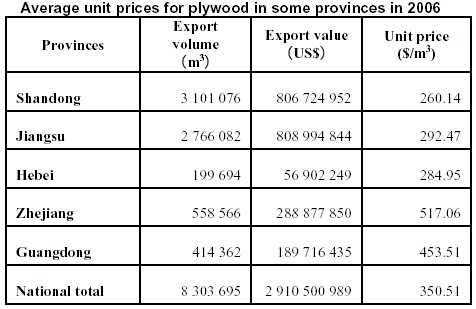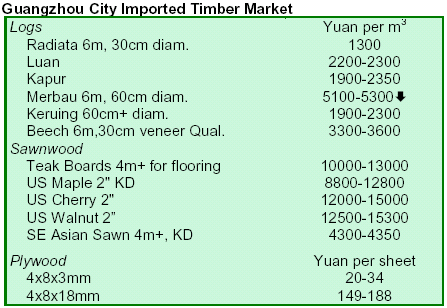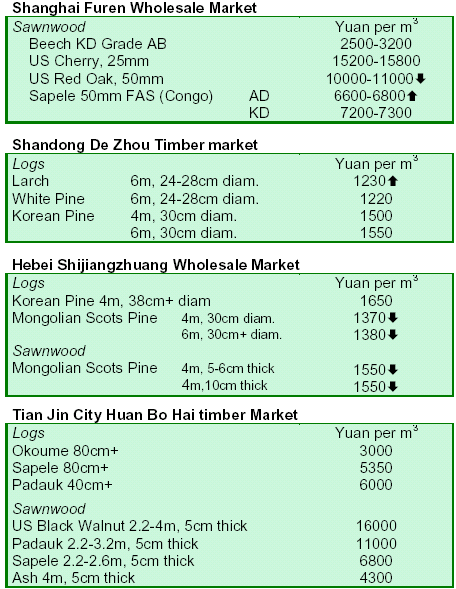US
Dollar Exchange Rates of 15th Sep.
2007
China Yuan
7.516
Report from China
Plywood industry boosted by high yielding plantations
Since 2001, fast growing and high yielding plantations in east, north and south China have
helped China¡¯s plywood industry to develop rapidly. This was particularly true in
Hebei, Shangdong and Jiangsu provinces where Italian poplar was introduced and cultivated. According to
statistics, plywood output of these three provinces in 2006 were 14.46 million m3, or 53% of
the national total.
The plywood industry developed rapidly in the South China region because of the cultivation of
fast growing eucalypts and production of cement templates from small diameter eucalypts. For
example, Guangdong¡¯s plywood output in 2006 had reached 2 million m3, up 39% from
2005, saving 5 million m3 of timber from natural forests. In addition, plywood production in Guangxi,
Fujian, Hunan, Jiangxi and Shanghai also grew quickly, especially in Guangxi and
Hainan.

Experts believe that China¡¯s plywood industry will keep growing in the near future, due to the
strong demand for plywood at both the national and international levels. However, China will have a continuing need to import
plywood from other countries.

Despite this growth in export volume and consumption in recent years, China¡¯s plywood
production chain must still deal with a number of problems. First, there are
insufficient raw materials for plywood production. To rectify this problem, the integration of forests and wood
based panels are key for the future development of the plywood industry. China will continue to need to import
high quality and large diameter timber, since it lacks forests resources, especially precious and large diameter
timber for production of face, back and decorative veneer.
Secondly, plywood quality is often lower in China and thus economic returns are not as high.
This effect is also magnified by the high number of family workshops. For example, in 2006, the average unit price for exported
plywood was nearly US$122 per cubic meter lower than the average unit price for imported plywood. In addition,
the average unit price for plywood differs greatly due tothe different quality of plywood in different production
areas.

Zhangjiang suffers from log overstocking
From November 2006 until June 2007, 1.5 million m3 of imported timber was overstocked in
Zhangjiang Port.Since imported timber filled the port zone to capacity, many sites around the
port zone had been rented to store imported timber resulting in timber traders losing up to
RMB10 million in business at Zhangjiang Port in the first half of 2007.
The reasons for overstocking include disorderly import of timber due to traders looking to take
higher profits and resulting in import volume exceeding domestic demand.Secondly, other
domestic and international factors caused domestic demand to fall. For example, China¡¯s
furniture, wood flooring and plywood industry continue to be subject to anti-dumping
investigations in Europe and the U.S. China also has a regulated export tax rebate policy.
Additionally, Chinese products must compete with prices for imported wooden products from
other Southeast Asian countries, for which are prices reduced and products reexported.
Finally, many traders focus only on gaining quantity over quality, which leads to higher than needed
stocks to take profits.
U.S. sawnwood exports to China to grow by 10%
In the first half of 2007, sawnwood board exports from the U.S. continued to grow. According to
local experts, sawnwood board exports from the U.S. will grow 10% to 776,000 m3. China will
be the top destination country of U.S. sawnwood board, exceeding Canada by 2009. The
main reasons for the increase are that China¡¯s timber imports from Russia, Malaysia and Indonesia
have been declining in recent years as a result of efforts to combat illegal logging and related
trade. Additionally, the price for U.S. red oak has a comparative advantage in quality
over Russia and the rest of Asia.
Jixiang invests RMB285 million to expand MDF production
Sichuan Leshan Jixiang Plantation Products Co., Ltd. are expected to invest RMB285 million to
expand its MDF production line, adding 210,000 m3 of production. An investment agreement for the expansion project had been
signed between Leshan City¡¯s government and China Jixiang Wood Industry. On completion, the annual MDF
output of Leshan Jixiang will be 300,000 m3, twice as much as its current output, and the annual output value
should reach RMB300 million. The project is expected to be complete by 2008.
Built in 1997, Leshan Jixiang is one of the most advanced enterprises in terms of its equipment and production
technology among wood-based industries in the Asia- Oceania region. The annual profits of Leshan Jixiang in
2006 were RMB400 million, and the company has helped generate income for about 108,000 farmers in China.
Largest laminate production project in Asia to be completed
During a signing ceremony at the Third China (Mudanjiang) Wood Industry Expo, an agreement
between Jiangsu Yurun Group and Dongning Jixin Industry and Trade Group signed an
agreement to create the largest laminate production project in Asia, and RMB1 billion
will be invested in the project. The two groups will be incorporated under the Dongning Jirun Wood
Industry Co, Ltd. Of the total amount invested, 560 million yuan will be dedicated to manufacture 150,000 m3 of
construction structure laminated panels annually in Dongning economic development zone. In Mudanjiang
economic and technology development zone, RMB120 million will be invested to manufacture 30,000 m3 of doors
and windows for construction. RMB320 million will be invested to manufacture two timber raw material bases
with 1 million m3 of annual logging volume.


¡¡
¡¡
¡¡
|